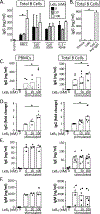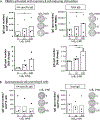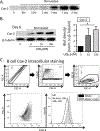Lipoxin B4 Enhances Human Memory B Cell Antibody Production via Upregulating Cyclooxygenase-2 Expression
- PMID: 30348736
- PMCID: PMC6246818
- DOI: 10.4049/jimmunol.1700503
Lipoxin B4 Enhances Human Memory B Cell Antibody Production via Upregulating Cyclooxygenase-2 Expression
Abstract
Vaccination has been the most effective way to prevent or reduce infectious diseases; examples include the eradication of smallpox and attenuation of tetanus and measles. However, there is a large segment of the population that responds poorly to vaccines, in part because they are immunocompromised because of disease, age, or pharmacologic therapy and are unable to generate long-term protection. Specialized proresolving mediators are endogenously produced lipids that have potent proresolving and anti-inflammatory activities. Lipoxin B4 (LXB4) is a member of the lipoxin family, with its proresolving effects shown in allergic airway inflammation. However, its effects on the adaptive immune system, especially on human B cells, are not known. In this study, we investigated the effects of LXB4 on human B cells using cells from healthy donors and donors vaccinated against influenza virus in vitro. LXB4 promoted IgG Ab production in memory B cells and also increased the number of IgG-secreting B cells. LXB4 enhanced expression of two key transcription factors involved in plasma cell differentiation, BLIMP1 and XBP1. Interestingly, LXB4 increased expression of cyclooxygenase-2 (COX2), an enzyme that is required for efficient B cell Ab production. The effects of LXB4 are at least partially COX2-dependent as COX2 inhibitors attenuated LXB4-stimulated BLIMP1 and Xpb-1 expression as well as IgG production. Thus, our study reveals for the first time, to our knowledge, that LXB4 boosts memory B cell activation through COX2 and suggests that LXB4 can serve as a new vaccine adjuvant.
Copyright © 2018 by The American Association of Immunologists, Inc.
Figures





Similar articles
-
Assessing human B cell responses to influenza virus vaccines and adjuvants in a PBMC-derived in vitro culture system.Vaccine. 2025 Jan 12;44:126563. doi: 10.1016/j.vaccine.2024.126563. Epub 2024 Dec 2. Vaccine. 2025. PMID: 39616951
-
Lipoxin A₄ modulates adaptive immunity by decreasing memory B-cell responses via an ALX/FPR2-dependent mechanism.Eur J Immunol. 2014 Feb;44(2):357-69. doi: 10.1002/eji.201343316. Eur J Immunol. 2014. PMID: 24166736 Free PMC article.
-
Lipoxin and synthetic lipoxin analogs: an overview of anti-inflammatory functions and new concepts in immunomodulation.Inflamm Allergy Drug Targets. 2006 Apr;5(2):91-106. doi: 10.2174/187152806776383125. Inflamm Allergy Drug Targets. 2006. PMID: 16613568 Review.
-
The generation of memory B cells is maintained, but the antibody response is not, in the elderly after repeated influenza immunizations.Vaccine. 2016 May 27;34(25):2834-40. doi: 10.1016/j.vaccine.2016.04.023. Epub 2016 Apr 20. Vaccine. 2016. PMID: 27108193 Free PMC article.
-
Keeping the memory of influenza viruses.Pathol Biol (Paris). 2010 Apr;58(2):e79-86. doi: 10.1016/j.patbio.2010.01.010. Epub 2010 Mar 19. Pathol Biol (Paris). 2010. PMID: 20303671 Review.
Cited by
-
Mimicking Gene-Environment Interaction of Higher Altitude Dwellers by Intermittent Hypoxia Training: COVID-19 Preventive Strategies.Biology (Basel). 2022 Dec 21;12(1):6. doi: 10.3390/biology12010006. Biology (Basel). 2022. PMID: 36671699 Free PMC article. Review.
-
Absorption of Polyunsaturated Fatty Acid (PUFA) Is Related to IgG Blood Levels of Neonatal Pigs during the First 48 Hours Postpartum.J Immunol Res. 2020 Feb 6;2020:3813250. doi: 10.1155/2020/3813250. eCollection 2020. J Immunol Res. 2020. PMID: 32090128 Free PMC article.
-
Role of specialized pro-resolving lipid mediators and their receptors in virus infection: a promising therapeutic strategy for SARS-CoV-2 cytokine storm.Arch Pharm Res. 2021 Jan;44(1):84-98. doi: 10.1007/s12272-020-01299-y. Epub 2021 Jan 4. Arch Pharm Res. 2021. PMID: 33398691 Free PMC article. Review.
-
Specialized Pro-Resolving Mediators Mitigate Cancer-Related Inflammation: Role of Tumor-Associated Macrophages and Therapeutic Opportunities.Front Immunol. 2021 Jun 30;12:702785. doi: 10.3389/fimmu.2021.702785. eCollection 2021. Front Immunol. 2021. PMID: 34276698 Free PMC article. Review.
-
Lipoxins in the Nervous System: Brighter Prospects for Neuroprotection.Front Pharmacol. 2022 Jan 26;13:781889. doi: 10.3389/fphar.2022.781889. eCollection 2022. Front Pharmacol. 2022. PMID: 35153778 Free PMC article. Review.
References
-
- Mulligan MJ, Bernstein DI, Winokur P, Rupp R, Anderson E, Rouphael N, Dickey M, Stapleton JT, Edupuganti S, Spearman P, Ince D, Noah DL, Hill H, Bellamy AR, and Group DHNVS 2014. Serological responses to an avian influenza A/H7N9 vaccine mixed at the point-of-use with MF59 adjuvant: a randomized clinical trial. JAMA 312: 1409–1419. - PubMed
-
- Serhan CN 2007. Resolution phase of inflammation: novel endogenous anti-inflammatory and proresolving lipid mediators and pathways. Annu Rev Immunol 25: 101–137. - PubMed
Publication types
MeSH terms
Substances
Grants and funding
LinkOut - more resources
Full Text Sources
Medical
Research Materials

